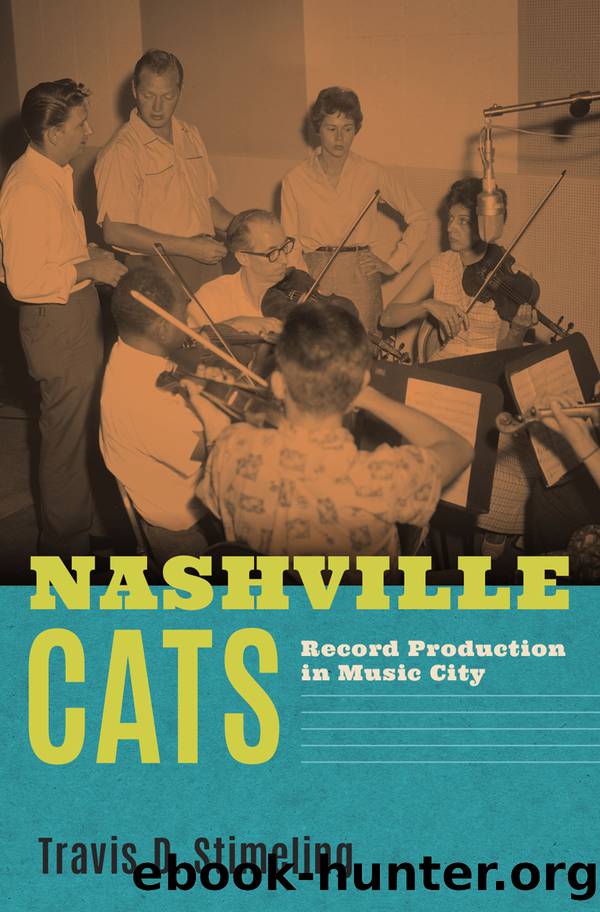Nashville Cats by Travis D. Stimeling

Author:Travis D. Stimeling
Language: eng
Format: epub
Publisher: Oxford University Press
Published: 2020-08-15T00:00:00+00:00
Robbinsâs interests in rock and roll also led him to pick up the saxophone, which he played onstage when âthe piano wasnât in good enough shape to really compete with the loud guitars and drums. . . .â128
Such broad musical interests undoubtedly helped him as he began to seek professional opportunities as a session musician, much as it had helped many other musicians in the Nashville A Team. Unfortunately for Robbins, though, the piano duties at most sessions were already covered, initially leaving him with demo sessions.129 But when Cramer scored a hit with âLast Date,â he serviced fewer accounts, leaving room for Robbins, who had learned Cramerâs slip-note approach. As he told Green: âFloyd Cramer had come out with âLast Dateâ and then kind of retired from the recording scene after that . . . [,] and when he quit, I was really just about the only one around who could play in that pedal style that was so popular, and that didnât hurt me any.â130 Robbins also pointed to the expansion of the Nashville studio scene as another factor that made space for him to work more regularly, noting that âthe business was really growing, and that kind of made room for another band, because one or two bands had it more or less sewed up before. It was an exciting time for me. I couldnât wait to get up out of bed in the morning to get at it.â131
Although Robbins could emulate the Cramer style, Green notes that Robbins âdeveloped his own distinct style at the keyboard by featuring the melody in the left hand played against the chords in the right. Robbins calls this his âMaybelle Carterâ technique, because it echoes the famous guitar style pioneers in the 1920s by playing the melody on her bass strings and strumming the treble for rhythm.â132 It is particularly interesting that both Cramer and Robbins credited Carter as the source of their piano style, but that both of them developed their own interpretation of that style in their respective work. Cramerâs style seems to have focused primarily on Carterâs tendency to use hammer-ons (playing an open string and then striking the string on a fret) and pull-offs (playing a stopped string and pulling the finger away to let the open string ring), as revealed by his tendency to use approach the third of a chord from beneath (much as a guitarist might move from an open A string to a fretted B in a G major chord) and the sixth from above (much as a guitarist might play a fretted E on the D string before releasing the string in a G major chord). These hammer-ons and pull-offs are quite commonly heard in the broad string band tradition, particularly on the guitar and banjo, so Cramerâs efforts represent a rather broad interpretation of that approach.133 Robbins, on the other hand, reveals a more nuanced take on the Carter style, acknowledging that Carter played the melodies on the guitarâs bass strings, and working diligently to emulate that approach.
Download
This site does not store any files on its server. We only index and link to content provided by other sites. Please contact the content providers to delete copyright contents if any and email us, we'll remove relevant links or contents immediately.
The Goal (Off-Campus #4) by Elle Kennedy(13368)
Kathy Andrews Collection by Kathy Andrews(11680)
Diary of a Player by Brad Paisley(7416)
What Does This Button Do? by Bruce Dickinson(6100)
Assassin’s Fate by Robin Hobb(6057)
Big Little Lies by Liane Moriarty(5648)
Altered Sensations by David Pantalony(5005)
Pale Blue Dot by Carl Sagan(4858)
Sticky Fingers by Joe Hagan(4064)
The Death of the Heart by Elizabeth Bowen(3484)
The Heroin Diaries by Nikki Sixx(3448)
Beneath These Shadows by Meghan March(3225)
Confessions of a Video Vixen by Karrine Steffans(3206)
How Music Works by David Byrne(3079)
The Help by Kathryn Stockett(3043)
Jam by Jam (epub)(2983)
Harry Potter 4 - Harry Potter and The Goblet of Fire by J.K.Rowling(2942)
Strange Fascination: David Bowie: The Definitive Story by David Buckley(2760)
Petty: The Biography by Warren Zanes(2637)
